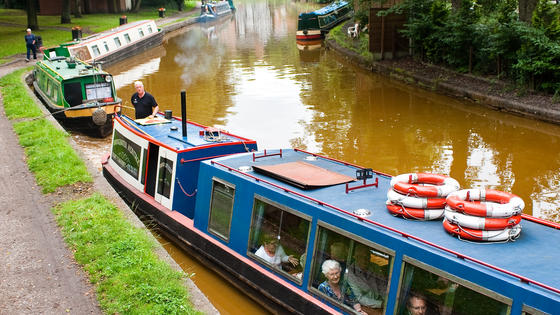
The Bridgewater Canal is famous for its orange colouration. The colour gets stronger as you approach Worsley and every passing boat is followed by a swirl of orange as the sediment at the bottom of the canal is stirred up. The colour has been compared to a good strong cup of builder's tea.
Opinions vary about this distinctive feature. Some see it as unsightly and polluting. Others think the unusual colour scheme of Worsley, with the orange water setting off the black and white of the nearby buildings, creates an unmistakeable and dramatic scene.
But where does this strange colour scheme come from? Like the origins of Worsley itself the answer lies deep in the Duke of Bridgewater’s coal mines.
Coal formed in layers of rock laid down in the geological time that we call the Carboniferous era. Warm swampy areas allowed growth of forests, very different to our present day flora, consisting of tree ferns, horsetails and clubmosses. Every now and then the forests were inundated with floods and covered by layers of sediment. Over thousands of years a complex series of carbon rich plant layers built up with grit layers in between. These became buried and compressed, subjected to faulting and upheavals and eventually became layers of rock known as the coal measures. Many years later some of these coal layers were exposed on the surface by erosion. They were discovered by the developing human populations when we finally evolved about 300 million years later.
Finding that these strange black rocks would burn people began to value the land under which they could be found. The Duke of Bridgewater, like other landowners in Lancashire, decided to make the most of the abundant resources on his estate. With the help of his Land Agent John Gilbert, tunnelling was carried out in to the Duke's land northwards from Worsley. The coal their workers brought out helped to fuel the Industrial Revolution.
One of the characteristics of Carboniferous rock formations is a high level of iron in the deposits. The highest concentrations can be exploited to extract iron for metal working but even where it is not at such levels it is still there, trapped in the rocks. Mining for coal allows water to percolate down into the bedrock and the iron is oxidised, making it more more mobile. The iron leaches out of the rocks, carried by moving water. This means that fragments of iron oxide, or rust as it is generally known, are carried out in drainage from the mine. The Bridgewater Canal is essentially a drainage channel from the underground levels. Although mining no longer takes place the water continues to trickle through the coal measures bringing iron oxide out and depositing it as sludge in the passageways of the mine and eventually out in the canal. In the early days of the canal the sludge was collected and sold to make ‘ochre’ pigments for paints but that is no longer done.
To many people the orange-coloured water is just evidence of pollution. Where this phenomenon affects naturally flowing streams and rivers the Coal Authority make every effort to reduce the effects. Although the Bridgewater Canal is not a natural waterway the Coal Authority have still tried to reduce the iron oxide levels in the canal by pumping water from the entrance of the mines to settling lagoons on the far side of the motorway. Here the water passes gradually through reed beds where the iron oxide is deposited and some of the iron is absorbed by the plants. Cleaner water is then returned to the canal through a sluice just west of Worsley. Some local people mourn the dilution of the iconic colour scheme which they see as a striking reminder of the canal's industrial heritage.
Despite the discolouration of the canal, wildlife has managed to thrive. The sight of herons, cormorants and kingfishers is clear evidence that there are healthy populations of fish and other small creatures in the Bridgewater's orange waters.







